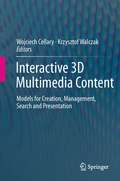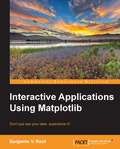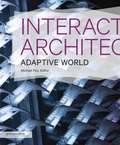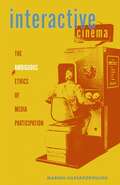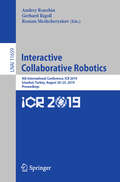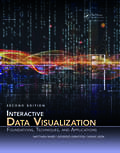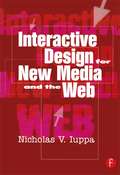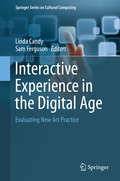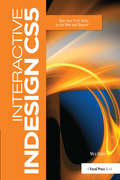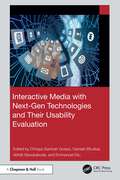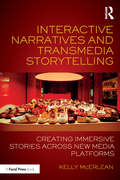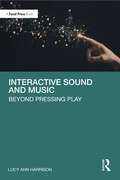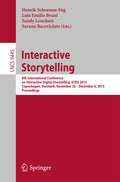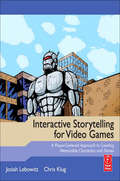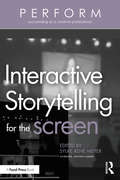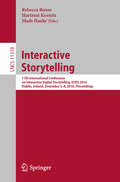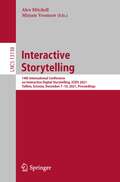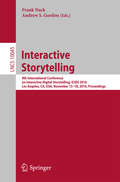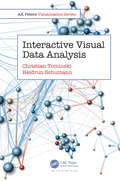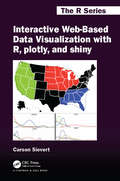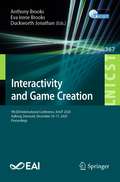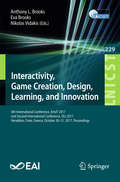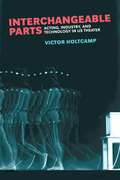- Table View
- List View
Interactive 3D Multimedia Content
by Krzysztof Walczak Wojciech CellaryThe book describes recent research results in the areas of modelling, creation, management and presentation of interactive 3D multimedia content. The book describes the current state of the art in the field and identifies the most important research and design issues. Consecutive chapters address these issues. These are: database modelling of 3D content, security in 3D environments, describing interactivity of content, searching content, visualization of search results, modelling mixed reality content, and efficient creation of interactive 3D content. Each chapter is illustrated with example applications based on the proposed approach. The final chapter discusses some important ethical issues related to the widespread use of virtual environments in everyday life. The book provides ready to use solutions for many important problems related to the creation of interactive 3D multimedia applications and will be a primary reading for researchers and developers working in this domain.
Interactive Applications Using Matplotlib
by Benjamin V. RootThis book is intended for Python programmers who want to do more than just see their data. Experience with GUI toolkits is not required, so this book can be an excellent complement to other GUI programming resources.
Interactive Architecture: Adaptive World
by Michael FoxRecent technological developments in biology, computation, cybernetics, engineering, industrial design, materials, and robotics allow architecture to evolve beyond static functionality and become an active participant--with the capacity to perceive, react to, and connect--with humans and the natural world. The first process-based guide by Michael Fox and Miles Kemp introduced interactive architecture in 2009, and the past few years have seen its prototypical potential unleashed, manifest in the eighteen inventive projects featured in this follow-up, the latest in our Architecture Briefs series.Interactive Architecture: Adaptive World illustrates how structures can process information, make observations, and utilize tools to translate natural systems and create seamlessly integrated environments, from data-driven light installations, responsive sculptures, and performative materials, to smart highways, dynamic spaces, kinetic facades, and adaptive buildings. Ambitious projects from around the world, including Abu Dhabi, Indianapolis, Los Angeles, New York City, San Francisco, Frankfurt, London, Paris, Sochi, and Zurich, are illuminated by photographs, diagrams, and renderings.
Interactive Cinema: The Ambiguous Ethics of Media Participation (Electronic Mediations #63)
by Marina HassapopoulouConnecting interactive cinema to media ethics and global citizenship Interactive Cinema explores various cinematic practices that work to transform what is often seen as a primarily receptive activity into a participatory, multimedia experience. Surveying a multitude of unorthodox approaches throughout the history of motion pictures, Marina Hassapopoulou offers insight into a range of largely ephemeral and site-specific projects that consciously assimilate viewers into their production. Analyzing examples of early cinema, Hollywood B movies, museum and gallery installations, virtual-reality experiments, and experimental web-based works, Hassapopoulou travels across numerous platforms, highlighting a diverse array of strategies that attempt to unsettle the allegedly passive spectatorship of traditional cinema. Through an exploration of these radically inventive approaches to the medium, many of which emerged out of sociopolitical crises and periods of historical transition, she works to expand notions of interactivity by considering it in both technological and phenomenological terms. Deliberately revising and expanding Eurocentric scholarship to propose a much broader, transnational scope, the book emphasizes the ethical dimensions of interactive media and their links to larger considerations around community building, citizenship, and democracy. By combining cutting-edge theory with updated conventional film studies methodologies, Interactive Cinema presses at the conceptual limits of cinema and offers an essential road map to the rapidly evolving landscape of contemporary media.
Interactive Collaborative Robotics: 4th International Conference, ICR 2019, Istanbul, Turkey, August 20–25, 2019, Proceedings (Lecture Notes in Computer Science #11659)
by Andrey Ronzhin Gerhard Rigoll Roman MeshcheryakovThis book constitutes the refereed proceedings of the 4th International Conference on Interactive Collaborative Robotics, ICR 2019, held in Istanbul, Turkey, in August 2019. The 32 papers presented in this volume were carefully reviewed and selected from 46 submissions. They deal with challenges of human-robot interaction; robot control and behavior in social robotics and collaborative robotics; and applied robotic and cyber-physical systems.
Interactive Data Processing and 3D Visualization of the Solid Earth
by Daniel PatelThis book presents works detailing the application of processing and visualization techniques for analyzing the Earth’s subsurface. The topic of the book is interactive data processing and interactive 3D visualization techniques used on subsurface data. Interactive processing of data together with interactive visualization is a powerful combination which has in the recent years become possible due to hardware and algorithm advances in. The combination enables the user to perform interactive exploration and filtering of datasets while simultaneously visualizing the results so that insights can be made immediately. This makes it possible to quickly form hypotheses and draw conclusions. Case studies from the geosciences are not as often presented in the scientific visualization and computer graphics community as e.g., studies on medical, biological or chemical data. This book will give researchers in the field of visualization and computer graphics valuable insight into the open visualization challenges in the geosciences, and how certain problems are currently solved using domain specific processing and visualization techniques. Conversely, readers from the geosciences will gain valuable insight into relevant visualization and interactive processing techniques. Subsurface data has interesting characteristics such as its solid nature, large range of scales and high degree of uncertainty, which makes it challenging to visualize with standard methods. It is also noteworthy that parallel fields of research have taken place in geosciences and in computer graphics, with different terminology when it comes to representing geometry, describing terrains, interpolating data and (example-based) synthesis of data. The domains covered in this book are geology, digital terrains, seismic data, reservoir visualization and CO2 storage. The technologies covered are 3D visualization, visualization of large datasets, 3D modelling, machine learning, virtual reality, seismic interpretation and multidisciplinary collaboration. People within any of these domains and technologies are potential readers of the book.
Interactive Data Visualization: Foundations, Techniques, and Applications, Second Edition
by Daniel Keim Matthew O. Ward Georges GrinsteinAn Updated Guide to the Visualization of Data for Designers, Users, and ResearchersInteractive Data Visualization: Foundations, Techniques, and Applications, Second Edition provides all the theory, details, and tools necessary to build visualizations and systems involving the visualization of data. In color throughout, it explains basic terminology
Interactive Design for New Media and the Web
by Nick IuppaIn an age where digital technology makes just about anything possible, Interactive Design for New Media and the Web demonstrates how to realize that promise through the creation of outstanding interactive programs. This hands-on, practical book examines the ever-expanding capabilities of all forms of digital presentation for increasing interactivity, and the design principles and interface guidelines needed to deliver the required message or story with this technology. Interactive Design for New Media and the Web covers the technology as well as the tools and practices of interactive design, including the creation of site maps and flow charts, and the writing of design documents. It examines the latest interactive features of DVD, as well as the newest techniques and technologies for other forms of digital presentation. New design templates, 3D graphics and animation, polling and use of cookies, distance learning, html, and intranet learning games are among the topics covered in this book. Examples and case studies demonstrate the broad range of applications from websites to CD-ROM games to successful web commerce sites, including the capacity for user participation in e-commerce.The companion Website shows numerous examples discussed in the text of all types of programs and their applications.
Interactive Experience in the Digital Age
by Linda Candy Sam FergusonThe use of interactive technology in the arts has changed the audience from viewer to participant and in doing so is transforming the nature of experience. From visual and sound art to performance and gaming, the boundaries of what is possible for creation, curating, production and distribution are continually extending. As a consequence, we need to reconsider the way in which these practices are evaluated. Interactive Experience in the Digital Age explores diverse ways of creating and evaluating interactive digital art through the eyes of the practitioners who are embedding evaluation in their creative process as a way of revealing and enhancing their practice. It draws on research methods from other disciplines such as interaction design, human-computer interaction and practice-based research more generally and adapts them to develop new strategies and techniques for how we reflect upon and assess value in the creation and experience of interactive art. With contributions from artists, scientists, curators, entrepreneurs and designers engaged in the creative arts, this book is an invaluable resource for both researchers and practitioners, working in this emerging field.
Interactive InDesign CS5: Take your Print Skills to the Web and Beyond
by Mira RubinPrint designers make the transition to multimedia by mastering the interactive capabilities of InDesign with this tutorial-based guide to the new CS5 toolset that integrates with the Adobe Flash platform.
Interactive Media with Next-Gen Technologies and Their Usability Evaluation
by Emmanuel Eilu Ganesh Bhutkar Chhaya Santosh Gosavi Abhijit BanubakodeInteractive media are a human-machine interface that allows people to connect with each other by making them active participants in the media they consume through text, graphics, audio and video. This book presents the challenges and opportunities presented by emerging media technologies to explore usability evaluation. It covers the current trends in interactive media technologies such as, Social Media, Dark Patterns, Internet of Things (IoT), Android Development, Assistive Technologies and Augmented Reality (AR) / Virtual Reality (VR). It explores various application areas such Education, Film and Television, Agriculture, Cyber Security, Bird Conservation, Smart Vehicles, Fashion Technology and e-Learning.Key features of this edited book are as follows:● Evaluates related Interactive Media Technologies and Applications for assessment and enhancement of their usability● Illustrates current discussions on Interactive Media Technologies such as Social Media, Dark Patterns, Internet of Things (IoT), Android Development, Assistive Technologies and Augmented Reality (AR) / Virtual Reality (VR)● Includes various case studies from application areas such as Education, Film and Television, Agriculture, Cyber Security, Bird Conservation, Smart Vehicles, Fashion Technology and e-Learning, which are helpful for researchers● Presents concept illustrations with appropriate figures, tables and suitable descriptions in a reader-friendly way This book is ideal for both beginners and experts working in the fields of HCI, Multimedia Techniques and Next-Gen Technologies.
Interactive Narratives and Transmedia Storytelling: Creating Immersive Stories Across New Media Platforms
by Kelly McErleanInteractive Narratives and Transmedia Storytelling provides media students and industry professionals with strategies for creating innovative new media projects across a variety of platforms. Synthesizing ideas from a range of theorists and practitioners across visual, audio, and interactive media, Kelly McErlean offers a practical reference guide and toolkit to best practices, techniques, key historical and theoretical concepts, and terminology that media storytellers and creatives need to create compelling interactive and transmedia narratives. McErlean takes a broad lens, exploring traditional narrative, virtual reality and augmented reality, audience interpretation, sound design, montage, the business of transmedia storytelling, and much more. Written for both experienced media practitioners and those looking for a reference to help bolster their creative toolkit or learn how to better craft multiplatform stories, Interactive Narratives and Transmedia Storytelling serves as a guide to navigating this evolving world.
Interactive Segmentation Techniques: Algorithms and Performance Evaluation
by C.-C. Jay Kuo Jia He Chang-Su KimThis book focuses on interactive segmentation techniques, which have been extensively studied in recent decades. Interactive segmentation emphasizes clear extraction of objects of interest, whose locations are roughly indicated by human interactions based on high level perception. This book will first introduce classic graph-cut segmentation algorithms and then discuss state-of-the-art techniques, including graph matching methods, region merging and label propagation, clustering methods, and segmentation methods based on edge detection. A comparative analysis of these methods will be provided with quantitative and qualitative performance evaluation, which will be illustrated using natural and synthetic images. Also, extensive statistical performance comparisons will be made. Pros and cons of these interactive segmentation methods will be pointed out, and their applications will be discussed. There have been only a few surveys on interactive segmentation techniques, and those surveys do not cover recent state-of-the art techniques. By providing comprehensive up-to-date survey on the fast developing topic and the performance evaluation, this book can help readers learn interactive segmentation techniques quickly and thoroughly.
Interactive Sound and Music: Beyond Pressing Play
by Lucy Ann HarrisonInteractive Sound and Music: Beyond Pressing Play provides an accessible exploration into the aesthetics of interactive audio, using examples from video games, experimental music, and participatory theatre and sound installations. Offering a practitioner’s perspective, the book places interactive sound and music within a broader aesthetic context relating to key texts and discussion within musicology and wider art practices. Each chapter takes the reader through a key debate surrounding interactive sound and music, such as: Is it actually interactive and does it actually matter? How do audience expectations change in an interactive space? How do you compose for multiple possibilities? Is interactive sound and music ever finished? Where now for interactive sound and music? Supported by a series of questions at the end of each chapter that can be used as a focus for seminar or reading group activities, this is an ideal textbook for students on audio engineering, music technology, and game audio courses, as well as an essential guide for anyone interested in interactive sound and music.
Interactive Storytelling
by Henrik Schoenau-Fog Luis Emilio Bruni Sandy Louchart Sarune BaceviciuteThis book constitutes the refereed proceedings of the 8th International Conference on Interactive Digital Storytelling, ICIDS 2015, held in Copenhagen, Denmark, in November/December 2015. The 18 revised full papers and 13 short papers presented together with 9 posters, 9 workshop descriptions, and 3 demonstration papers were carefully reviewed and selected from 80 submissions. The papers are organized in topical sections on theoretical and design foundations, technical advances, analyses and evaluation systems, and current and future usage scenarios and applications.
Interactive Storytelling for Video Games: Proven Writing Techniques for Role Playing Games, Online Games, First Person Shooters, and more
by Chris Klug Josiah LebowitzWhat really makes a video game story interactive? What's the best way to create an interactive story?How much control should players be given? Do they really want that control in the first place?Do they even know what they want-or are their stated desires at odds with the unconscious preferences?All of these questions and more are examined in this definitive book on interactive storytelling for video games. You'll get detailed descriptions of all major types of interactive stories, case studies of popular games (including Bioshock, Fallout 3, Final Fantasy XIII, Heavy Rain, and Metal Gear Solid), and how players interact with them, and an in-depth analysis of the results of a national survey on player storytelling preferences in games. You'll get the expert advice you need to generate compelling and original game concepts and narratives.With Interactive Storytelling for Video Games, you'll:
Interactive Storytelling for the Screen (PERFORM)
by Sylke Rene MeyerAn invaluable collection of essays and interviews exploring the business of interactive storytelling, this highly accessible guide offers invaluable insight into an ever-evolving field that is utilizing new spatial and interactive narrative forms to tell stories. This includes new media filmmaking and content creation, a huge variety of analog story world design, eXtended realities, game design, and virtual reality (VR) design. The book contains essays written by and interviews with working game designers, producers, 360-degree filmmakers, immersive theatre creators, and media professors, exploring the business side of interactive storytelling – where art meets business. Contributors to this book share their perspectives on how to break into the field; how to develop, nurture, and navigate business relationships; expectations in terms of business etiquette; strategies for contending with the emotional highs and lows of interactive storytelling; how to do creative work under pressure; the realities of working with partners in the field of new media narrative design; prepping for prototyping; writing analog and digital. This is an ideal resource for students of filmmaking, screenwriting, media studies, RTVF, game design, VR and AR design, theater, and journalism who are interested in navigating a career pathway in the exciting field of interactive storytelling.
Interactive Storytelling: 11th International Conference on Interactive Digital Storytelling, ICIDS 2018, Dublin, Ireland, December 5–8, 2018, Proceedings (Lecture Notes in Computer Science #11318)
by Rebecca Rouse Hartmut Koenitz Mads HaahrThis book constitutes the refereed proceedings of the 11th International Conference on Interactive Digital Storytelling, ICIDS 2018, held in Dublin, Ireland, in December 2018. The 20 revised full papers and 16 short papers presented together with 17 posters, 11 demos, and 4 workshops were carefully reviewed and selected from 56, respectively 29, submissions. The papers are organized in the following topical sections: the future of the discipline; theory and analysis; practices and games; virtual reality; theater and performance; generative and assistive tools and techniques; development and analysis of authoring tools; and impact in culture and society.
Interactive Storytelling: 14th International Conference on Interactive Digital Storytelling, ICIDS 2021, Tallinn, Estonia, December 7–10, 2021, Proceedings (Lecture Notes in Computer Science #13138)
by Alex Mitchell Mirjam VosmeerThis book constitutes the refereed proceedings of the 14th International Conference on Interactive Digital Storytelling, ICIDS 2021, held in Tallinn, Estonia, in December 2021. The 18 full papers and 17 short papers, presented together with 17 posters and demos, were carefully reviewed and selected from 99 submissions. The papers are categorized into the following topical sub-headings: Narrative Systems; Interactive Narrative Theory; Interactive Narrative Impact and Application; and the Interactive Narrative Research Discipline and Contemporary Practice.
Interactive Storytelling: 9th International Conference on Interactive Digital Storytelling, ICIDS 2016, Los Angeles, CA, USA, November 15–18, 2016, Proceedings (Lecture Notes in Computer Science #10045)
by Frank Nack Andrew S. GordonThis book constitutes the refereed proceedings of the 9th International Conference on Interactive Digital Storytelling, ICIDS 2016, held in Los Angeles, CA, USA, in November 2016. The 26 revised full papers and 8 short papers presented together with 9 posters, 4 workshop, and 3 demonstration papers were carefully reviewed and selected from 88 submissions. The papers are organized in topical sections on analyses and evaluation systems; brave new ideas; intelligent narrative technologies; theoretical foundations; and usage scenarios and applications.
Interactive Visual Data Analysis (AK Peters Visualization Series)
by Christian Tominski Heidrun SchumannIn the age of big data, being able to make sense of data is an important key to success. Interactive Visual Data Analysis advocates the synthesis of visualization, interaction, and automatic computation to facilitate insight generation and knowledge crystallization from large and complex data. The book provides a systematic and comprehensive overview of visual, interactive, and analytical methods. It introduces criteria for designing interactive visual data analysis solutions, discusses factors influencing the design, and examines the involved processes. The reader is made familiar with the basics of visual encoding and gets to know numerous visualization techniques for multivariate data, temporal data, geo-spatial data, and graph data. A dedicated chapter introduces general concepts for interacting with visualizations and illustrates how modern interaction technology can facilitate the visual data analysis in many ways. Addressing today’s large and complex data, the book covers relevant automatic analytical computations to support the visual data analysis. The book also sheds light on advanced concepts for visualization in multi-display environments, user guidance during the data analysis, and progressive visual data analysis. The authors present a top-down perspective on interactive visual data analysis with a focus on concise and clean terminology. Many real-world examples and rich illustrations make the book accessible to a broad interdisciplinary audience from students, to experts in the field, to practitioners in data-intensive application domains. Features: Dedicated to the synthesis of visual, interactive, and analysis methods Systematic top-down view on visualization, interaction, and automatic analysis Broad coverage of fundamental and advanced visualization techniques Comprehensive chapter on interacting with visual representations Extensive integration of automatic computational methods Accessible portrayal of cutting-edge visual analytics technology Foreword by Jack van Wijk For more information, you can also visit the author website, where the book's figures are made available under the CC BY Open Access license.
Interactive Web-Based Data Visualization with R, plotly, and shiny (Chapman & Hall/CRC The R Series)
by Carson SievertThe richly illustrated Interactive Web-Based Data Visualization with R, plotly, and shiny focuses on the process of programming interactive web graphics for multidimensional data analysis. It is written for the data analyst who wants to leverage the capabilities of interactive web graphics without having to learn web programming. Through many R code examples, you will learn how to tap the extensive functionality of these tools to enhance the presentation and exploration of data. By mastering these concepts and tools, you will impress your colleagues with your ability to quickly generate more informative, engaging, and reproducible interactive graphics using free and open source software that you can share over email, export to pdf, and more. Key Features: Convert static ggplot2 graphics to an interactive web-based form Link, animate, and arrange multiple plots in standalone HTML from R Embed, modify, and respond to plotly graphics in a shiny app Learn best practices for visualizing continuous, discrete, and multivariate data Learn numerous ways to visualize geo-spatial data This book makes heavy use of plotly for graphical rendering, but you will also learn about other R packages that support different phases of a data science workflow, such as tidyr, dplyr, and tidyverse. Along the way, you will gain insight into best practices for visualization of high-dimensional data, statistical graphics, and graphical perception. The printed book is complemented by an interactive website where readers can view movies demonstrating the examples and interact with graphics.
Interactivity and Game Creation: 9th EAI International Conference, ArtsIT 2020, Aalborg, Denmark, December 10–11, 2020, Proceedings (Lecture Notes of the Institute for Computer Sciences, Social Informatics and Telecommunications Engineering #367)
by Anthony Brooks Eva Irene Brooks Duckworth JonathanThis book constitutes the refereed post-conference proceedings of the 9th International Conference on Interactivity and Game Creation, ArtsIT 2020, held in Aalborg, Denmark, in December 2020. Due to COVID-19 pandemic the conference was held virtually. The 28 revised full papers presented were carefully selected from 60 submissions. The papers represent a forum for the dissemination of cutting-edge research results in the area of arts, design and technology, including open related topics like interactivity and game creation. They are grouped in terms of content on art, installation and performance; games; design; intelligence and creativity in healthcare; wellbeing and aging.
Interactivity, Game Creation, Design, Learning, and Innovation: 5th International Conference, Artsit 2016, And First International Conference, Dli 2016, Esbjerg, Denmark, May 2-3, 2016. Proceedings (Lecture Notes of the Institute for Computer Sciences, Social Informatics and Telecommunications Engineering #196)
by Anthony L. Brooks Eva Brooks Nikolas VidakisThis book constitutes the proceedings of two conferences: The 6th International Conference on ArtsIT, Interactivity and Game Creation (ArtsIT 2017) and the Second International Conference on Design, Learning and Innovation (DLI 2017). The event was hosted in Heraklion, Crete, Greece, in October 2017 and attracted 65 submissions from which 50 full papers were selected for publication in this book. The papers represent a forum for the dissemination of cutting-edge research results in the area of arts, design and technology, including open related topics like interactivity and game creation.
Interchangeable Parts: Acting, Industry, and Technology in US Theater (Theater: Theory/Text/Performance)
by Victor HoltcampWhile Hollywood has long been called “The Dream Factory,” and theatrical entertainment more broadly has been called “The Industry,” the significance of these names has rarely been explored. There are in fact striking overlaps between industrial rhetoric and practice and the development of theatrical and cinematic techniques for rehearsal and performance. Interchangeable Parts examines the history of acting pedagogy and performance practice in the United States, and their debts to industrial organization and philosophy. Ranging from the late nineteenth century through the end of the twentieth, the book recontextualizes the history of theatrical technique in light of the embrace of industrialization in US culture and society. Victor Holtcamp explores the invocations of scientific and industrial rhetoric and philosophy in the founding of the first schools of acting, and echoes of that rhetoric in playwriting, production, and the cinema, as Hollywood in particular embraced this industrially infected model of acting. In their divergent approaches to performance, the major US acting teachers (Lee Strasberg, Stella Adler, and Sanford Meisner) demonstrated strong rhetorical affinities for the language of industry, illustrating the pervasive presence of these industrial roots. The book narrates the story of how actors learned to learn to act, and what that process, for both stage and screen, owed to the interchangeable parts and mass production revolutions.
